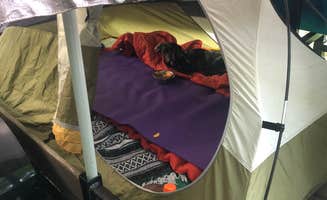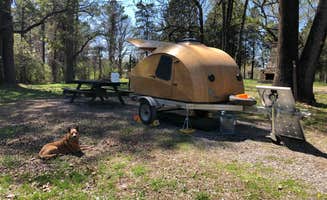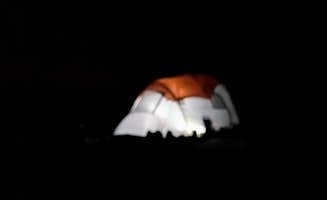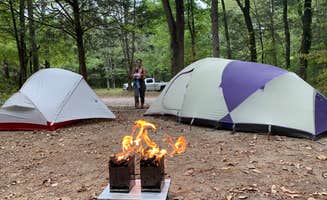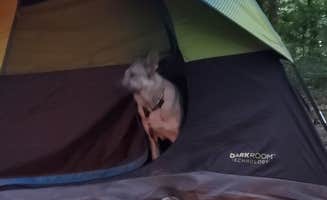Tent campsites near Cave-In-Rock, Illinois occupy a hilly region with elevations ranging from 320 to 850 feet, creating diverse camping terrain within the eastern section of Shawnee National Forest. This area receives approximately 45 inches of annual rainfall, contributing to the lush forest environment. Several campgrounds in this region maintain historic Civilian Conservation Corps structures that add historical interest to camping experiences.
What to do
Water activities on the Ohio River: Twin Lakes Campground offers direct water access for boating and fishing. The campground features "sites tucked away from others, sits right on the North-South trail, and sites 5 & 6 are blended into a bigger group type campsite."
Hike to overlooking vistas: Trails near Dutchman Lake Camp provide scenic viewpoints with minimal crowds. This area offers "beautiful little spots as you come in. Quiet and easy to get too." Most trails include moderate elevation changes suitable for intermediate hikers.
Wildlife observation: Early morning hours at smaller camping areas provide optimal wildlife viewing. A camper noted that Saline County State Conservation Area offers "fantastic views of the lake" and they "hiked Garden of the Gods and Burden Falls in the Shawnee National Forest. The hikes were great."
What campers like
Secluded camping settings: Smith Bay Campground provides waterfront sites with natural beaches. A visitor mentioned, "We stayed at a site right off the water. We kayak so it was perfect for us to leave them on the shoreline so we could come and go as we please. It is a rocky beach but very clean. Just a short paddle away are some sandy beaches."
Historical structures: CCC stonework at Camp Cadiz draws history enthusiasts. A camper shared, "I love this campground. It's super quiet despite the gravel road nearby. The vault restroom is kept very clean. It has easy access to the River to River trail, and I love the CCC stonework."
Night sky viewing: The limited light pollution creates optimal stargazing conditions. At Old Boy Scout Campground, a visitor reported it's "primitive and out of the way. Great for what it is." Another camper noted this area is "very out grown, hasn't been mowed or maintained in more than 8 or 10 years (according to the Park Rangers), and 'not for the faint of heart.'"
What you should know
Seasonal closures and flooding: Several campgrounds experience high water issues. At Twin Lakes, a visitor shared, "Follow the directions to the Twin Lakes sign, then take the turn by the 'boat ramp' sign on the left at the fork. Follow it back a good ways, and it will open to the campground."
Water access varies: Not all sites offer potable water. At Camp Cadiz, a camper noted, "The water pump got frequent use and the twin vault toilets were plenty for the campground."
Remote camping preparation: Limited services require advance planning. A visitor to Turkey Ridge Campground reported, "Stayed here 3 nights in travel trailer. Water available to fill your holding tank and in couple of locations in campground. #35 is a nice location. Large yard and not super close to other campers. #53 is smaller but very private."
Wildlife encounters: Store food securely due to active wildlife. At Smith Bay Campground, someone warned, "Raccoons and skunks visit the campsites nightly, so you must keep everything put away or risk a big mess like some we saw who had left there food out on a screened gazebo/tent."
Tips for camping with families
Beginner-friendly trails: Several short hiking loops accommodate young hikers. At Turkey Ridge Campground, a visitor advised, "Rebman trail is good for anyone including little kids."
Swimming areas with gradual entry: Certain river and lake access points offer safer swimming. At Smith Bay, a camper noted, "We didn't have any neighbors so it didn't bother us much. Only downside is we were right next to a rope swing so kids were playing there majority of the day."
Bug protection requirements: Insect activity increases near water. When staying at Dutchman Lake Camp, a visitor observed, "The lake surface had a lot of bug activity - no thanks! We ended up choosing a grassy space next to the curve in the road in between our neighbors. Very peaceful! No bugs."
Educational opportunities: Historic structures provide learning experiences. At Lake Mauzy East, a camper shared, "This is an amazing spot for free camping! The tent pads are right by the water, offering stunning lake views. Each site comes equipped with a fire ring, picnic table, and access to toilets—everything you need for a comfortable stay."
Tips from RVers
Road access limitations: Many campgrounds have narrow access roads. At Cravens Bay, an RVer reported, "We stayed at site 20 with a 36' travel trailer we had to actually drive all the way to the end of the campground to turn around so we could back into the site. The road leading into the campsite is paved but narrow, the roads at the campsite are well hard packed gravel and very narrow."
Leveling challenges: Bring leveling blocks for uneven sites. One camper at Smith Bay noted, "Most campers here are in tents. I suspect this is because the sites are not very level."
Generator etiquette: Generator use should be limited to daytime hours. A camper at Smith Bay warned, "Our visit last week was cut short by a rude RVer who fired up his extremely loud generator at 11 pm and left it sputtering away until 8 am."
Supply planning: Limited services require thorough preparation. A visitor to Turkey Ridge shared, "There were several hiking trails that looked pretty, but we didn't get a chance to walk them. Overall, this is a nice and quiet campground. We would definitely stay again. We camped at Ferne Clyffe State Park in a Motorhome."


